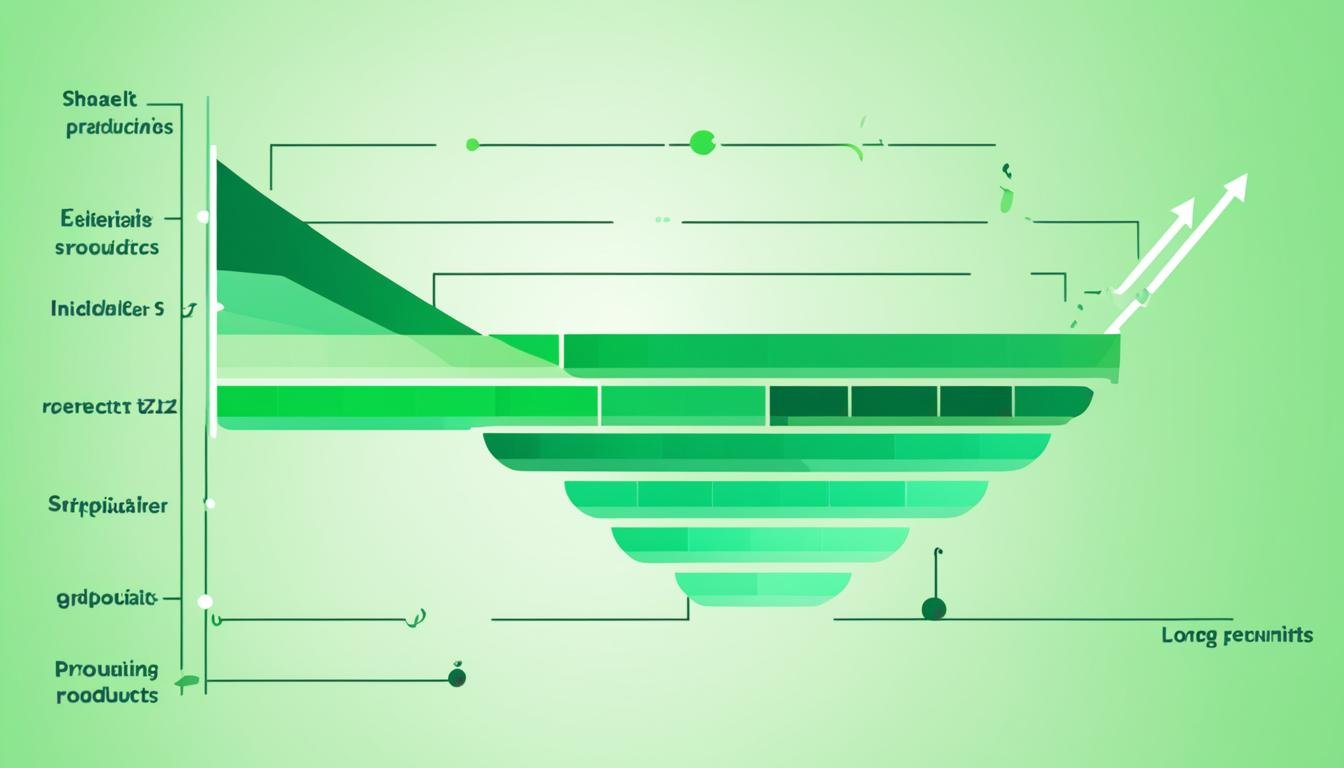The Long Tail: Selling Less of More
Did you know that Wal-Mart only stocks about 4,500 different CDs? But online, the choice is much wider. Chris Anderson introduced “The Long Tail” in his book on July 11, 2006. This idea changed how we think about retail and marketing.
Anderson found that 98 percent of songs on Ecast’s digital jukeboxes get played every quarter. This shows that many products, even the ones not everyone knows, can still make a big impact. This idea is now a key part of how big online stores like Amazon and Apple work.
Anderson’s idea is different from the old way of focusing on just a few top products. Now, we see a shift towards more specialized products. For example, fewer people are going to the movies, but more are watching special cable channels.
Anderson’s book was even nominated for a big award in 2006. It shows how this new way of doing business affects both companies and customers. It makes us think differently about how we sell things online.
Key Takeaways
- Chris Anderson’s book ‘The Long Tail: Selling Less of More’ was published on July 11, 2006.
- The concept reveals the potential market power of niche products collectively.
- E-commerce platforms like Amazon have successfully implemented The Long Tail strategy.
- Traditional hit-driven markets are declining in popularity, giving way to niche markets.
- The strategy emphasizes broad distribution channels to tap into diverse consumer interests.
Understanding the Concept of The Long Tail
Chris Anderson introduced The Long Tail, changing how businesses see demand and market reach. It shows how niche products can be big sellers, even more so than popular ones. This is true when they use the vast online distribution channels.
Origins of The Long Tail
In 2004, Chris Anderson brought up “The Long Tail” in Wired magazine. He looked at Ecast’s digital jukebox and saw a new way to sell music. With no limits on shelf space, companies could sell many different items to lots of people.
This idea was perfect for online stores, where there are no physical limits.
Evolution and Popularity
Chris Anderson’s idea has become key in retail. The Long Tail shows that less common items can make money with lower costs. With digital stores like Amazon and iTunes, there’s more room for these items.
These platforms let customers find many options, helping niche markets grow. Data shows more people are buying niche products today.
The rise of niche products also lowered the cost of making and sharing goods. This change has changed the market. Despite some doubts, niche products keep growing online, showing how important The Long Tail is today.
The Economics Behind The Long Tail
The Long Tail idea changes how we sell things, moving from just focusing on top sellers to valuing a wide range of products. This shift uses demand distribution and niche markets profitability. It takes advantage of digital platforms to reach many different consumer interests.
Long Tail Economics Explained
Long Tail economics is about how online stores can cut costs and sell many niche products. Stores like Wal-Mart once carried about 4,500 CDs, focusing on the top 20 albums. But online stores like Amazon and Netflix offer many less popular items, making them more accessible.
Rhapsody’s data from December 2005 showed people still listened to less popular songs, even as hits sold less. This shows the value of offering a wide range of products.
“98% of the 10,000 available albums on Ecast’s internet-connected jukeboxes had a track chosen at least once each quarter.”
This shows how digital markets can make niche markets profitable, even with low sales for each item. Chris Anderson points out that technology and platforms like YouTube and MySpace help even amateurs succeed. This shows a big change in e-commerce economics.
Comparison with Traditional Markets
Traditional markets often follow the Pareto principle, where a few products sell a lot. Retailers focused on these popular items, leaving little room for niche products. But digital markets are different.
Here, the long-tailed distribution curve shows that less popular items make up a big part of the market. This offers a big business opportunity over time.
The internet has made it easier to have lower inventory and marketing costs. This lets businesses tap into niche markets that wouldn’t work in physical stores. By doing this, companies can meet diverse customer interests, increase customer satisfaction, and create steady revenue streams. This changes the way we think about demand distribution and e-commerce economics.
Impact on Niche Markets
The Long Tail strategy has changed niche markets a lot. It makes it easier for people to find a wide range of products and services. Now, businesses don’t just focus on selling a lot of items. They can meet the unique needs of people in micro-niches.
Advantages for Consumers
Consumers get a lot of benefits from the Long Tail. They have more consumer choice than before. Online stores can carry a huge variety of products, from bestsellers to rare finds. This means people can find books, videos, and music that they might not have seen in stores.
This gives consumers the chance to buy things they really like. Whether it’s a rare book, an indie movie, or special music, the Long Tail makes it possible. Sites like Amazon and Netflix show how the Long Tail can offer a world of choices, helping people discover new things.
Benefits for Businesses
Businesses gain a lot from this change too. They can reach customers in micro-niches and build a loyal group of customers. By offering many niche products, they can make more money and not rely on just a few big hits.
Online stores like iTunes and Google don’t have to worry about running out of space. This lets them offer a huge variety of products. Companies like Airbnb and YouTube do well by giving people unique options. For example, Airbnb has everything from regular apartments to treehouses and houseboats.
The Long Tail makes the market more open and creative. It lets small businesses compete with big ones. This means more choices for consumers and a lively market with products for everyone’s taste.
Product Variety and Inventory Optimization
Companies using The Long Tail model need to balance their inventory to meet demand and cut costs. They do this by offering more products. This way, they can serve different tastes and meet specific market needs.
Strategies for Inventory Management
Managing inventory well is key for The Long Tail businesses. Thanks to data analysis and digital storage, companies can keep just the right amount of stock. This approach cuts down on storage costs and makes things more efficient.
Using just-in-time inventory and tech for tracking helps operations run smoother. It also makes sure customers get what they need.
Extending Product Lines
Adding more products is a big part of The Long Tail strategy. By offering a wider variety of niche items, companies can attract more customers. Research shows that having more products online benefits consumers much more than lower prices.
This highlights how important it is to have diverse products. With low costs for storage and shipping, selling less popular items is possible. This approach can greatly improve customer happiness and help businesses grow.
The Role of E-commerce in The Long Tail
E-commerce has changed the game for the Long Tail theory, thanks to Chris Anderson’s book, The Long Tail: Why the Future of Business Is Selling Less of More. It’s all about focusing on niche markets instead of just the big hits. This shift has led to huge success stories in e-commerce.
Success Stories: Amazon, Netflix, and More
Amazon and Netflix are top examples of e-commerce success. They’ve changed how we shop and watch movies by offering a huge variety of products and shows. Amazon lets small sellers reach people all over the world, showing how e-commerce can grow big.
Netflix has also changed the game in entertainment. It doesn’t just focus on big hits. It also has a lot of lesser-known movies and shows. This approach helps Netflix keep a wide range of viewers happy, showing how digital distribution can reach more people.
Implementing Long Tail Strategies in E-commerce
Businesses want to be like Amazon and Netflix? They should use Long Tail strategies in e-commerce. This means offering lots of products to meet the needs of different groups of people. Using data helps find out what people like, which helps in making smart choices about what to sell.
SEO that targets long-tail keywords also helps e-commerce sites get noticed. Since most searches are for specific things, focusing on these keywords can bring in more customers. This approach can lead to big success in e-commerce.
E-commerce platforms can use the Long Tail to grow and thrive in today’s digital world. They do this by making sure they offer a wide range of products and reach out to different groups of people.
The Importance of Personalization and Customization
In today’s market, making things personal and unique is key for businesses to stand out. By understanding what customers want, companies can offer experiences that really speak to them. This approach not only makes customers more loyal but also gets them more involved.
Enhancing Customer Experience
Personalized marketing is a big deal for making customers happy. By really getting to know what people want, companies can offer exactly what they need. This means more than just suggesting products. It’s about making communication personal, offering special deals, and even letting customers customize products. This builds a closer bond between brands and their customers.
Using Data Analytics for Customization
Data analytics is a big part of making marketing personal. It helps businesses understand what customers like and what they’re looking for. This way, companies can change their products and marketing to match what customers want. Using tools like customer toolkits can also help businesses stay ahead, especially when they really know their market. This keeps them competitive and helps them grow.
“The study emphasized the need for coherence and coupling between capabilities and processes for business model success.”
Leveraging On-Demand Manufacturing
In today’s changing market, on-demand manufacturing is a key strategy for businesses. It lets companies make products only when they are needed, cutting down on the need for big stockpiles. This change is thanks to new manufacturing tech and just-in-time production.
Technological Innovations in Manufacturing
New tech like 3D printing and advanced CNC machines is changing how we make things. These tools let businesses quickly and efficiently create custom items. This is important because customers now want a wide range of unique products.
Smart manufacturing systems and IoT devices have made making things faster and more efficient. They help companies make products just in time, without wasting time or money. This tech is key for staying competitive in today’s fast-paced market.
Examples of On-Demand Production
On-demand production is making a big impact in many industries. Companies like Amazon and Etsy use it to offer lots of unique products. Amazon uses its big network to quickly meet customer demands, offering over 350 million products.
Etsy has nearly 7.5 million sellers and serves over 96 million shoppers. Many of these shoppers look for custom and handmade items.
ICZOOM, a B2B e-commerce platform, has grown fast by using on-demand production in electrical components. This approach lets ICZOOM meet specific customer needs without keeping a lot of stock. This shows how on-demand production can work in different markets.
On-demand manufacturing is changing how we make things. It’s made possible by new tech and just-in-time production. These changes help businesses meet the complex needs of today’s market efficiently.
Navigating Micro-targeting Strategies
Micro-targeting strategies are key in today’s market. They help businesses reach specific groups with targeted marketing. By understanding consumer behavior, brands can create marketing that really speaks to people.
Understanding Your Audience
Knowing your audience is vital for micro-targeting. Businesses collect lots of data to make detailed customer profiles. They use surveys, look at purchase history, and check social media to get to know their customers.
Effective Micro-targeting Techniques
Good micro-targeting uses advanced algorithms and analytics. Companies like Amazon and Netflix use these to give users content they’ll like. By digging into customer behavior, businesses can make their marketing hit the mark.
To sum up, micro-targeting is about knowing your audience well and using data to connect with them. This leads to marketing that matters more and helps businesses do better.
Challenges and Criticisms of The Long Tail
Chris Anderson’s Long Tail idea changed how businesses view niche markets. But, it’s not without its problems and doubts. Experts have pointed out issues with its lasting power and its effect on the market.
Criticism from Industry Experts
Harvard Business School’s Anita Elberse has spoken out. She looked at music and video sales through Nielsen SoundScan and Nielsen VideoScan. Her study showed that even with more niche products, big hits still lead in sales.
This goes against Anderson’s idea that niche items would beat mainstream hits. Elberse found people still prefer popular products over niche ones. This leads to a market filled with many low-demand items that don’t make much money.
Overcoming Limitations
Companies aiming for The Long Tail need new strategies. One way is to mix niche and mainstream products. Sites like eBay and Amazon show how important it is to manage stock and suggest products well.
Technology and data analysis can help too. Using smart recommendation engines and targeting specific keywords can help reach niche groups better. Also, watching how customers act helps companies update their products to stay relevant.
Even with the challenges, companies that do well in The Long Tail can find big chances. They can meet the varied needs of their customers, build a loyal base, and stay strong in the market.
Source Links
- The Long Tail (book)
- Long Tail : Why the Future of Business Is Selling Less of More
- The Long Tail
- Long Tail: Definition as a Business Strategy and How It Works
- Should You Invest in the Long Tail?
- ‘The Long Tail’ Foresees a Marketplace of Pixel-Size Niches (Published 2006)
- Long tail
- Unlocking the Hidden Gems: The Power of the Long Tail Effect in Modern Commerce
- What Is The Long Tail And How Can It Benefit Your Business?
- Long Tail Effect
- What Everyone Got Wrong About ‘the Long Tail’
- The Long Tail – Wikipedia, the free encyclopedia
- Rethinking the Long Tail Theory: How to Define ‘Hits’ and ‘Niches’
- Chris Anderson – The Long Tail: Why the Future of Business Is Selling Less of More
- The Long Tail challenge and the e-commerce business
- Surviving on the long tail: An empirical investigation of business model elements for mass customization
- Long Tail Marketing Explained with Examples – TheBigMarketing.com
- Long Tail in Marketing: Apply That Ish to Content Strategy
- What is long tail and how leveraging it can bring us closer to sustainability goals
- The Long Tail PDF Summary – Chris Anderson | 12min Blog
- Long Tail Distribution: Marketing in the Long Tail: Unleashing the Potential of Distribution – FasterCapital
- What Is Long Tail In Marketing? | Long Tail Theory Explained
- No title found







